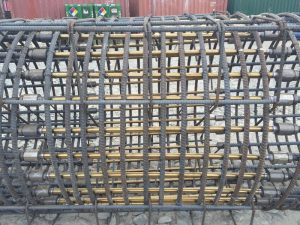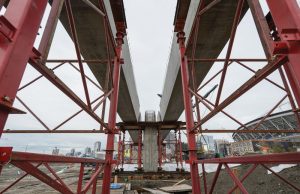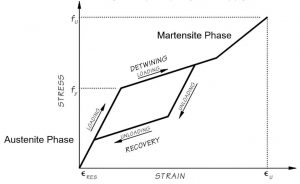The current seismic design philosophy for bridges in high seismic risk areas is prescribed by nationally accepted design standards that have been based on laboratory testing since the 1960s. For ordinary bridges that are expected to experience strong seismic ground motions, this philosophy prescribes structural details that have been shown to provide a low probability of collapse.
To construct a modern, economical bridge that meets this criterion, it is acceptable for elements of the structure to suffer significant damage. As long as the bridge does not collapse and users can safely get off the structure, the design is considered successful. Using conventional construction methods to construct a bridge without significant damage is typically considered to be uneconomical.
The typical energy dissipation mechanism for modern economical multi-span bridges is to allow plastic hinging. For bridges, the plastic hinge is designed to be a short portion of the length of the steel reinforced concrete column, where the column connects to the crossbeam and where the column connects to the foundation.
The plastic hinge mechanism using conventional materials requires permanent damage to elements that are critical to the serviceability and stability of a bridge. A bridge experiencing the ground motions of a design earthquake may experience permanent damage, such as yielding of the longitudinal steel reinforcement in the plastic hinge region and crushing or spalling of the conventional concrete. This type of damage may lead to restricting the types of vehicles that can use the bridge or require complete closure. The damage may require costly repair or replacement of the column, and may even require replacement of the bridge.
With research support from the University of Nevada, Reno (UNR) – one of the top earthquake engineering laboratories in the U.S. – the Washington State Department of Transportation (WSDOT) has constructed a first real-world pilot project bridge. The project incorporated innovative materials in the plastic hinge region that will not only eliminate the need for permanent damage of the structure but also provide a necessary energy dissipation mechanism.
Replacing conventional materials in the plastic hinge region with innovative materials can improve the seismic resilience of bridge structures. Conventional steel reinforcement can be replaced with a superelastic shape memory alloy (SMA), and conventional concrete can be replaced with engineered cementitious composite (ECC).
Shape Memory Alloy
Shape memory alloys (SMA) have historically been used in robotics, automotive, biomedical, and aerospace applications. Superelastic shape memory alloys for this type of bridge application are a special type of metal that is manufactured from a combination of nickel and titanium. The metal is shaped into smooth round bars that replace longitudinal steel rebar in the plastic hinge region of bridge columns.
Conventional steel rebar used in bridges will return to its original and undeformed shape if not stressed beyond its yield point. Rebar is sized for strength and service limit states to remain below this limit. If stressed beyond the yield point, conventional rebar will exhibit residual deformation after unloading. Deformation of the conventional rebar beyond the yield point is essential to dissipate energy during a seismic event. The challenge of relying on deformation beyond the yield point is that the structure will not be operational after a seismic event.
For SMA, the alloy will deform like steel beyond the yield point, but it will return to its undeformed shape. This means the alloy is superelastic. Energy can still be dissipated by stretching the SMA and, once the earthquake motions subside, the SMA will return to its original shape.
Superelastic shape memory alloys undergo crystalline structure phase transformations, between the austenite and martensite phases when stressed. When the alloy is loaded in the austenite phase, the material will behave linearly, similar to steel up to the yield point. The alloy will transform into the twinned, martensite phase as loading continues. In the twinned state, the crystalline structure is oriented to allow the microstructure to shear without breaking molecular bonds when stressed. As loading continues beyond the yield point, the martensite will begin to de-twin, allowing the alloy to behave plastically. When unloading follows, the martensite will transform back to austenite and the material recovers to its original undeformed shape.
The SMA is only needed for energy dissipation in the plastic hinge region. Therefore, the SMA is not needed for the entire height of the column or elsewhere in the bridge. As compared to conventional steel rebar, SMA alloys are expensive, so the SMA is only used in the plastic hinge regions of the column. Due to the difficulty of machining this specific alloy, headed couplers have been shown to be the only feasible means to couple the SMA to steel rebar.
Engineered Cementitious Composite
Engineered cementitious composite (ECC) is a cement-based mixture that is similar to conventional concrete used in modern reinforced columns. A typical ECC mix contains water, cement, fine sand, polyvinyl alcohol fibers, and chemical admixtures. The key difference between conventional concrete and ECC is that the coarse aggregates are replaced with fibers to provide improved ductile performance. The inclusion of the fiber gives ECC the ability to have a tensile strain capacity as high as six times that of conventional concrete. The high tensile and compressive strain ductility cause ECC to not spall like conventional concrete. The ductility, tensile strength, and unique cracking behavior make ECC a much more resilient material compared to conventional concrete.
First Implementation
Together, these innovative materials work to provide an energy dissipation mechanism similar to that which is incorporated into modern bridges, but will significantly reduce the risk of damage to the structure and eliminate respective repair costs. This will create a bridge that is more likely to remain serviceable after significant earthquake ground motions and reduce or eliminate the need for repair or replacement.
M.‘Saiid’ Saiidi, Ph.D., P.E., F.ASCE, at UNR, has performed extensive research and testing to validate the use of these innovative materials in bridges. There have been several levels of testing completed, including small scale testing of the SMA and ECC to establish material properties, testing of individual columns for specific plastic hinge performance, and full-scale multiple-span bridges subjected to earthquake motions from the shake table equipment in the Earthquake Engineering Laboratory at UNR.
WSDOT decided to incorporate SMA and ECC into a new bridge that is part of the State Route 99 Alaskan Way Viaduct Replacement project in the Sodo district of Seattle, WA. The primary overall goal of this mega-project is to replace the seismically damaged and compromised Alaskan Way Viaduct structure with a single-bore tunnel under the core of the city (See the tunnel article in the January 2019 issue of STRUCTURE). This bridge is one of many in the vicinity of the south portal of the new tunnel. It will serve as a northbound off-ramp that will span over two roadway alignments providing access to the tunnel.
The bridge is a three-span, 400-foot long structure carrying two lanes of traffic and has a roadway width of 30½ feet. The bridge superstructure consists of two lines of prestressed, precast concrete tub girders. The abutments have a semi-integral end diaphragm and are founded on 8-foot diameter drilled shafts.
The superstructure type and foundation type of this specific bridge is not necessary for the SMA and ECC to improve seismic resilience. Generally, these materials can be used where any conventional plastic hinges are currently being used.
To encourage new research technologies to be incorporated into practical projects, the Federal Highway Administration created the Innovative Bridge and Research Deployment (IBRD) program. This program granted funds in the amount of $400,000 for this WSDOT project. These funds were intended to cover the costs of lab testing at UNR, procuring the innovative materials, and project documentation costs.
After the completion of construction of the bridge, the Transportation Research Board published NCHRP Research Report 864: Seismic Evaluation of Bridge Columns with Energy Dissipating Mechanisms. This report provides guidelines for quantitative analysis and design methods and construction procedures to incorporate SMA and ECC in columns.
By incorporating shape memory alloy and engineered cementitious composite in a typical highway bridge, WSDOT has demonstrated that bridges in high seismic regions can be improved upon with a small investment in new innovative materials. Bridges subjected to earthquakes can perform without the need to rely on permanent damage to dissipate energy. This means that new bridges can remain operational and useful after an earthquake without costly repair or replacement.■




